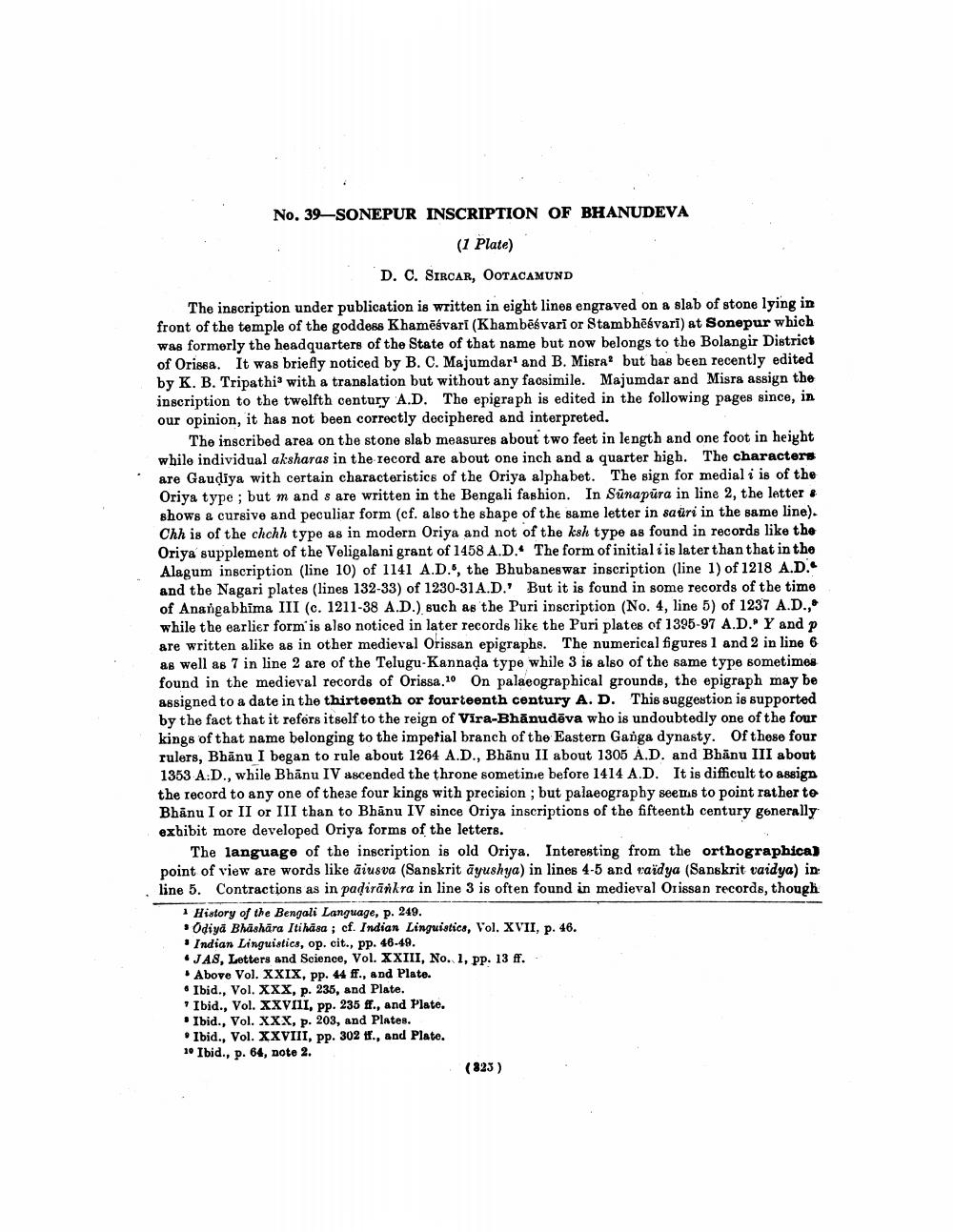________________
No. 39-SONEPUR INSCRIPTION OF BHANUDEVA
(1 Plate) D. C. SIRCAR, OOTACAMUND
The inscription under publication is written in eight lines engraved on a slab of stone lying in front of the temple of the goddess Khamēsvari (Khambēbvari or Stambhēsvarl) at Sonepur which was formerly the headquarters of the State of that name but now belongs to the Bolangir District of Orissa. It was briefly noticed by B. C. Majumdarand B. Misrabut has been recently edited by K. B. Tripathi' with a translation but without any facsimile. Majumdar and Misra assign the inscription to the twelfth century A.D. The epigraph is edited in the following pages since, in our opinion, it has not been correctly deciphered and interpreted.
The inscribed area on the stone slab measures about two feet in length and one foot in height while individual aksharas in the record are about one inch and a quarter high. The characters are Gaudiya with certain characteristics of the Oriya alphabet. The sign for medial i is of the Oriya type ; but m and s are written in the Bengali fashion. In Sunapura in line 2, the letter shows a cursive and peculiar form (cf. also the shape of the same letter in sauri in the same line). Chh is of the chchh type as in modern Oriya and not of the ksh type as found in records like the Oriya supplement of the Veligalani grant of 1458 A.D. The form of initial i is later than that in the Alagum inscription (line 10) of 1141 A.D.", the Bhubaneswar inscription (line 1) of 1218 A.D. and the Nagari plates (lines 132-33) of 1230-31 A.D.' But it is found in some records of the time of Anangabhima III (c. 1211-38 A.D.), such as the Puri inscription (No. 4, line 5) of 1237 A.D., while the earlier form is also noticed in later records like the Puri plates of 1395-97 A.D. Y and p are written alike as in other medieval Orissan epigraphs. The numerical figures 1 and 2 in line 6 as well as 7 in line 2 are of the Telugu-Kannada type while 3 is also of the same type sometimes found in the medieval records of Orissa. 10 On palaeographical grounde, the epigraph may be assigned to a date in the thirteenth or fourteenth century A. D. This suggestion is supported by the fact that it refers itself to the reign of Vira-Bhānudēva who is undoubtedly one of the four kings of that name belonging to the impetial branch of the Eastern Ganga dynasty. Of these four rulers, Bhānu I began to rule about 1264 A.D., Bhānu II about 1305 A.D. and Bhānu III about 1353 A.D., while Bhanu IV ascended the throne sometine before 1414 A.D. It is difficult to assign the record to any one of these four kings with precision ; but palaeography seems to point rather te Bhānu I or II or III than to Bhānu IV since Oriya inscriptions of the fifteenth century generally exbibit more developed Oriya forms of the letters.
The language of the inscription is old Oriya. Interesting from the orthographica) point of view are words like aiusva (Sanskrit āyushya) in lines 4-5 and raïdya (Sanskrit vaidya) in: line 5. Contractions as in padirānkra in line 3 is often found in medieval Orissan records, though
1 History of the Bengali Language, p. 249. • Odiya Bhashāra Itihasa ; cf. Indian Linguistics, Vol. XVII, p. 46. • Indian Linguistics, op. cit., pp. 46-49. • JAS, Letters and Science, Vol. XXIII, No. 1, pp. 13 ff.. . Above Vol. XXIX, pp. 44 ff., and Plate. . Ibid., Vol. XXX, p. 235, and Plate.
Ibid., Vol. XXVIII, pp. 235 ff., and Plate. • Ibid., Vol. XXX, p. 203, and Plates. . Ibid., Vol. XXVIII, pp. 302 tf., and Plate. 10 Ibid., p. 64, note 2.




